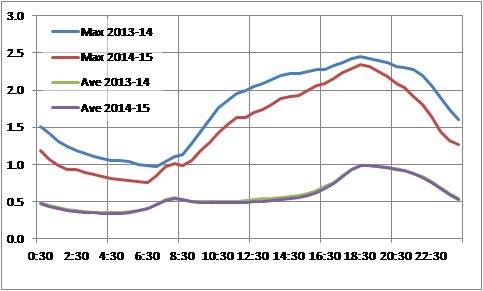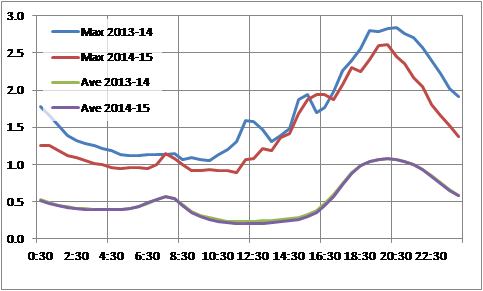by TRISTAN EDIS
28 MAY, 3:36 PM
SA Power Networks recent pricing proposal appears to suggest that the so-called push for “cost reflective tariff reform” is going down a path I had feared and warned it would (see:How to destroy solar while increasing peak demand from August 2014, and Solar’s contribution to peak demand from October 2013).
This involves power network monopolies exclusively targeting solar systems with higher charges under the subterfuge of trying to help the poor, but really to counter a possible future competitor. Meanwhile they avoid any meaningful restructuring of incentives for the remaining far larger customer base to address underlying drivers of network system costs because increased demand means increased revenue in the next regulatory period.
SA Power Networks have rather cleverly proposed that in order to help finance a heavily discounted tariff for low income consumers they’d like to increase the kilowatt-hour price owners of solar systems pay relative to other households by about 15%. This has been justified on the basis that it is intended to provide more efficient, cost reflective tariffs consistent with the Australian Energy Market Commission’s push for tariffs to incentivise more efficient use of network capacity. It also handily paints them as being about trying to help the poor rather than just protecting their business from a potential competitor.
Now, please don’t get me wrong, we do need to reform the way we structure power tariffs away from being based on a uniform price per kilowatt-hour no matter when or where it might be consumed (which, by the way, SA Power Networks doesn’t do in its proposal for either solar or non-solar customers, instead basing charges around a flat rate per kWh). We’ve already seen how this has led to increasingly poor utilisation of grid infrastructure with the advent of affordable air-conditioners that were historically well below best practice energy efficiency levels. We have large and expensive amounts of power infrastructure capacity laying idle for much of the year designed to satisfy demand levels that occur for only a small number of hours per year.
In addition as the work of Adjunct Professor Bill Grace of the University of WA has illustrated, the steadily improving economics of solar are such that it is conceivable that unless there’s some improved incentives to shift demand in time, then within just a decade we could end up with a massive glut of solar power in the middle of the day. Meanwhile, other generators would need to scramble like crazy for a few hours in the late afternoon/evening to ramp up to meet the surge in demand as we get home from work and school.
However it’s very important to recognise that unfair cost-shifting of the costs of coping with hot evening peak demand is not something that is dictated by whether or not a household happens to own a solar system or an air-conditioner. In the end there is incredible diversity in demand patterns across households even with a similar appliance mix. Analysis of several hundred NSW households’ 30-minute demand profile by the Australian Photovoltaics Institute has revealed this very large diversity about when a household’s demand actually hits its peak and by how much, including among solar customers (by the way, SA Power Networks, in the interests of informed debate and transparency, should make available publicly their full dataset on household demand patterns that they have used to justify higher charges to solar customers).
As just one example my household owns both a solar system and an air-conditioner and while my demand does drop away in the middle of the day and peak in the evening, the total quantum of my demand peak is low at about 1.5 kilowatts – 40% lower than the average of an SA Networks sample shown below.
Figure 1: NO SOLAR – SA Networks residential maximum and average load profile 2013/14 and 2014/15 (kW per customer)
Figure 2: WITH SOLAR – SA Networks sample of residential customers with solar installed – maximum and average load profile 2013/14 & 2014/15 (kW per customer)
Also, my demand peak happens in winter whereas the overall network faces its capacity constraints in summer.
So should I be whacked with extra charges because I happen to own a solar system and an air-conditioner? If more households were like mine the cost of operating the power system would be vastly cheaper than it is today.
We should be implementing tariffs that will provide a stronger incentive for people to shift their demand and also reduce it in absolute terms to reduce the need for costly power infrastructure. But SA Network’s solar tariff does nothing of the sort because the charge per kilowatt-hour is the same across the day. It is purely about cost recovery – while coming at the expense of longer term efficiency.
The reason why it comes at the expense of longer term efficiency is partly revealed in the two charts above. Now, the problematic part is that solar customers’ absolute peak isn’t mitigated by the solar system (they end up drawing a lot of power at 8.30pm when the sun has set) and it still overlaps with high demand from other households. However, the duration of the high demand period for someone with solar is more compressed than someone without. This is actually quite valuable, for two reasons:
1) The limits on network infrastructure capacity are a function not just of the absolute peak in throughput but also how long the high throughput lasts. Essentially, network capacity’s constraints are due to heat build-up. The assets can cope with surges in demand, but the longer they last the hotter the equipment gets and this is what drives failures and the need for upgrades. By reducing the duration of the peak and pushing it later in the day when it’s cooler, even if the absolute peak isn’t reduced, solar is lessening the load on network infrastructure.
2) Shifting demand across time requires effort from households and the more demand you need to shift over a longer period of time the more effort involved (a proxy for the burden is how many battery kilowatt-hours you’d need to buy). For the non-solar household to cut 0.5 kilowatts from their peak demand they’d need to shift that demand out of a very broad period of time: 13.30 to 21:30 – 8 hours. The solar household faces a less difficult task and could cut 0.5kW by just shifting demand out of the 17.30 to 21.30 period – 4 hours.
By proposing tariffs that impose higher charges for having a solar system while not making any effort to encourage customers to shift demand out of peak periods, SA Networks is acting to make the power system less efficient and more costly. This is the complete opposite of what it is suggesting it is trying to do, and is contrary to the AEMC’s directive of introducing tariffs that encourage reductions in peak demand.
For further information: http://www.businessspectator.com.au/article/2015/5/28/energy-markets/why-regulator-should-reject-sa-networks-solar-penalty?utm_source=exact&utm_medium=email&utm_content=1380668&utm_campaign=cs_daily&modapt=



